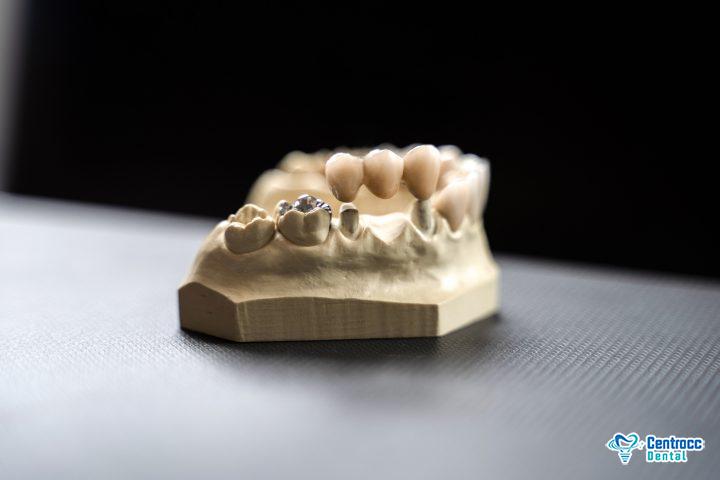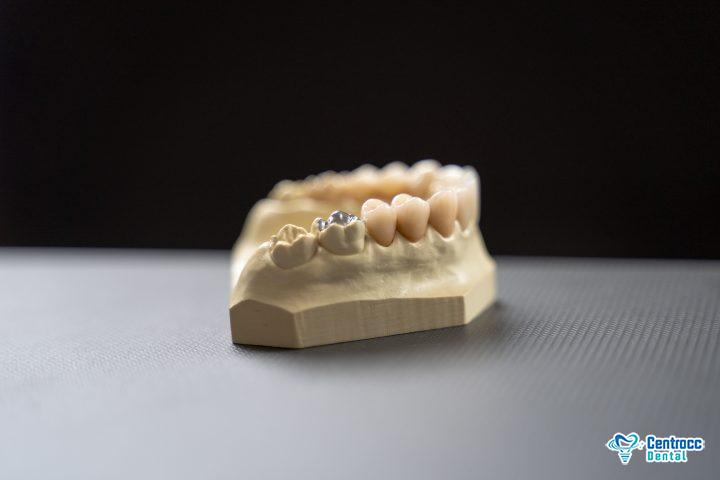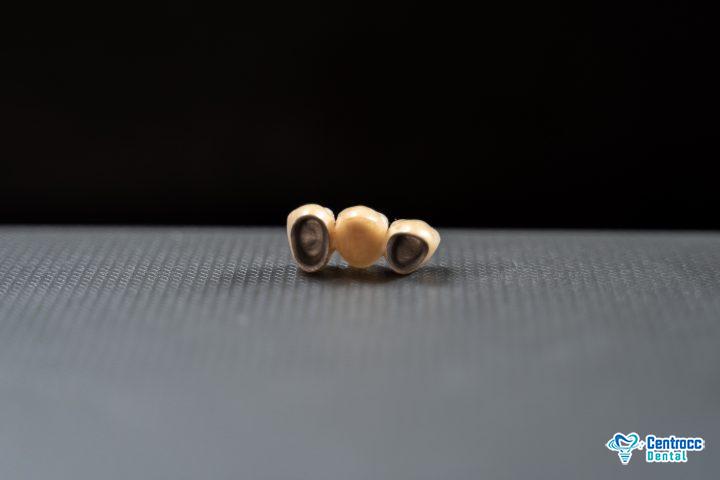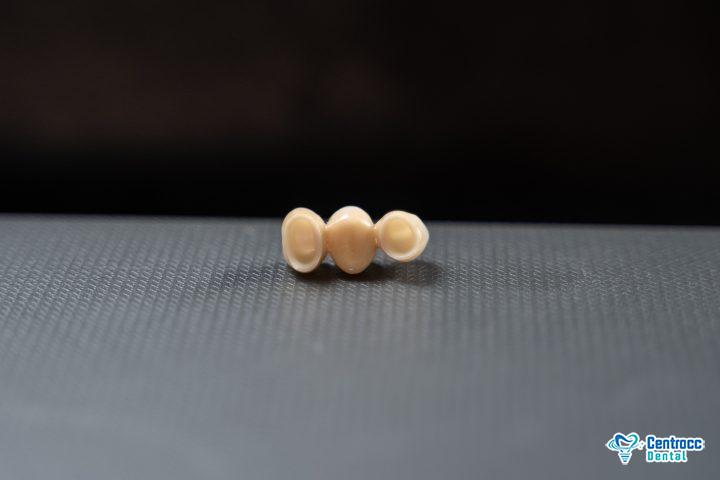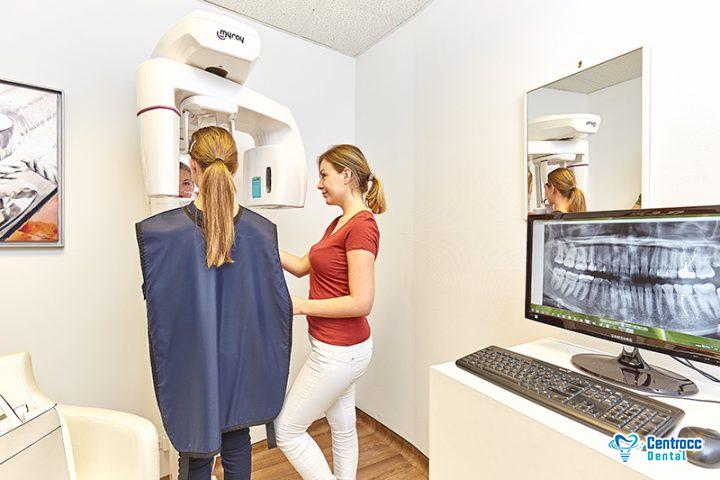A dental crown is a fixed denture that can be supported by an implant or a natural tooth. A dental crown is a “tooth-shaped cap” that covers the entire visible surface of the tooth and restores its original shape, colour and strength.
The bridge consists of several connected crowns, with the help of which we can make up for missing tooth/teeth. Like the crown, it can be attached to implants or the teeth.
When do we use dental crowns?
-
After root canal treatment.
Root canal treatment can cause discoloration of the tooth, thus covering it with a crown can be an aesthetic solution. In addition to the aesthetic improvement, it is much more important to acknowledge the fact that after root canal treatment the tooth is weakened and more prone to fracture than a healthy one (during the procedure the structure of the tooth weakens).
Consequently, there is a primarily functional reason for crowning the tooth after such a treatment.
-
When restoring heavily worn teeth.
In addition to today´s accelerated lifestyle, we tend to suffer from the effects of stress. One obvious manifestation of stress is the clenching or grinding of the teeth at night.
If it remains untreated for a long time, the patient can damage their own dental material almost completely. In such cases, only crowns can provide a long-term and effective solution.
-
In case of extensive cavities, if there is not enough healthy dental material for a filling or inlay.
The spread of caries is often so great that a tooth filling can no longer be applied after the removal of ill dental material (Such a large amount of dental material is missing that there is no residual tooth material left for the bonding of the filling, or the remaining and unsupported tooth material easily breaks off). In these cases, the tooth surface should be covered with a crown.
-
When restoring discoloured, improperly shaped teeth.
With crowns, discoloured, fractured, chipped or even damaged teeth can be altered to achieve the “perfect smile” look. During the aesthetic treatment, dental crowns can be made in shades and shapes according to the wishes of the patient.
They have a 100% resemblance of natural teeth. Although more dental material needs to be removed to make a crown than it does to make a dental veneer, but in many cases only the crown provides a durable and safe solution. With a carious tooth or a nonideal bite position, a dental veneer is not a long-term alternative.
-
When using an implant.
Dental crowns can be made for an implant, replacing the missing tooth or teeth. The crowns can be attached to the implant in different ways.
An intermediate mesostructure, called abutment, is used between the implant and the crown. The abutment attaches directly to the implant with a screw and is able to secure the crown to the implant.
The dental crown can be fixed by gluing or screw fixing.
The great advantage of the latter is that if the crown is damaged, it can be removed without any problems and then reattached after repair in the dental laboratory.
-
As part of a bridge, as a support pillar.
The dental bridge consists of several crowns which are connected to form a bridge. In case of tooth defects, the missing tooth or teeth can be replaced with a dental bridge.
How long does a crown last?
In our dental clinic, we provide a 3-year guarantee for every definitive crown. With regular control visits and a proper oral hygiene, the durability of crowns can be as long as 15-20 years.
What material can a dental crown be made of?
-
Metal ceramic crowns
The base of the crown is made of strong metal and the ceramic is layered on this frame, which gives the crown its final, natural shape, colour and appearance.
These crowns are durable, they restore the grinding teeth properly and they offer a more economical solution compared to metal-free crowns.
In our dental clinic, all metal ceramic crowns are made by computer-aided CAD/CAM process for maximum precision.
-
Zirconia crowns (CAD / CAM)
The crown base is made of zirconia, which is a white, extremely strong, biocompatible and durable material.
The base is manufactured by a special, computer-aided procedure, and then finished by our dental technicians.
The base that is manufactured by CAD / CAM technology provides exceptional accuracy. For this zirconium frame – like the metal ceramic crown – the ceramic coating is made layer by layer.
The biggest advantage of zirconia crowns over metal ceramic crowns is that with them we can achieve exceptionally high aesthetic results.
Thanks to the light transmittance of the crown and its white colour, which is similar to natural teeth, the metal edge is not visible, even at later retraction of the gums.
-
Lithium disilicate crowns (E-max)
The transparency and light transmittance of E-max crowns is closest to that of natural teeth.
The crown is the product of a special pressing process.
The final outlook of each crown is designed to meet our patients´ needs and made by our professional dental technicians.
-
Full-contour Zirconia Crowns
Anatomical full-contour zirconia crowns are made by computer-aided design.
The final anatomical shape is provided entirely by zirconium, so there is no need for any ceramic veneer.
The same colour as the natural teeth is achieved by a painting technique. Its advantage is that the ceramic part does not fracture making this type of crown the most resistant to chewing. It is mainly used in the chewing region.
The step-by-step process of making a dental crown
Dental crowns are completely lifelike, tooth-shaped “caps” that cover the tooth from all directions, restoring its colour, shape and strength. If you are not happy with the shape of your teeth, if you want perfectly even and symmetrical teeth, or if your teeth are damaged or broken due to caries or trauma, crowns can offer a permanent solution. Our highly trained prosthetists, who make thousands of crowns a year, and who work closely with a dental laboratory where we work only with the most modern Swiss, German, Swedish, American and Japanese materials, guarantee that each definitive crown is a perfectly natural, aesthetic result.
-
Personal consultation
During the consultation, our dentist will prepare a treatment plan according to your needs based on the oral examination and the panoramic X-ray. Your dentist will explain the full course of the treatment in detail and answer your questions. -
Your personalized treatment plan
Based on the panoramic X-ray, oral examination and personal preferences during the consultation, a treatment plan covering every detail will be provided. If no tooth extraction or other preparatory intervention is required, new crowns can be made even within one week.
-
Making your dental crown
If no preparatory interventions with a longer healing time are required (tooth extraction, root canal treatment), your dental crowns can be made in a few days. On the first day of your treatment, your dentist will prepare your teeth for the crowns which includes taking an impression (or a digital scan) and providing you with temporary crowns. You can choose the colour and shape of your new teeth from a brochure, and the crowns will be made by your dental technician according to your wishes. Once the crowns are done, your dentist will cement them so we can completely change your smile in as little as in a few days.
-
Regular check-ups
It is necessary to return to a follow-up examination every six months after the end of the treatment. During the control visit we can check the condition of the finished crowns, gums and teeth. We ensure that any problems that may arise we can handle in a timely manner.
What are the pros and cons of dental crowns?
Tooth crowns can be used to restore the original shape, colour and strength of the teeth that could not be built with other methods (e.g., with filling material).
In cases where a crown is applied on a broken, decayed, weakened teeth, the procedure has no drawbacks.
If one or more missing teeth are to be replaced with crowns, we are talking about a bridge, in which case the teeth neighbouring the gap must be shaved off so that the bridge can be placed on them.
In this case, to make up for the lack of teeth, intact dental material must be removed, which must be carefully considered in all cases, taking into account also other alternative solutions (e.g., dental implant).
In many cases, patients prefer crowns for their aesthetic benefits; they make the teeth look more symmetrical, regular, and whiter.
These treatments always involve the removal of intact dentures, and while aesthetically perfect results can be achieved, they require careful planning and consideration.
How to take care of dental crowns?
If we are talking about a single crown or crowns that are not part of bridge (so a separate, so-called solo crown is made for each tooth/implant), cleaning the crowns is the same as cleaning your own teeth.
The crowns should be thoroughly washed with a toothbrush and toothpaste at least twice a day, and the interdental spaces should be cleaned at least once a day with dental floss or preferably with interdental brush.
In addition, regular check-ups with your dentist and scaling every 6 months are highly advised. This will keep the gums and periodontal intact, and any problems that may arise will be diagnosed and treated in a timely manner.
In case of a bridge, special tools must be used for cleaning.
The areas under the bridge should be treated with a special floss designed for this purpose, called Superfloss. With the help of this, any food residue and plaque that may be stuck under the bridge (the area where the crown “rests” on the gums) can be removed.
What are the costs of a dental crown?
Making a crown depends on a number of factors.
The material of the crown, in other words the cost of the dental technology, has a primarily influence on the price of the crown.
Conventional metal ceramic crowns are much affordable than those made of a metal-free material, but they are not as aesthetically pleasing as their metal-free alternatives.
An important factor that also strongly influences the price of the crown is the technology and quality of the material used by the dental laboratory.
Nowadays, the highest quality crowns are manufactured by computer-aided CAD / CAM process, thus the production cost of these crowns is higher compared to traditional crowns made by wax patterning and casting.
Whether it is a metal ceramic, zirconia or E-max crown, the cost of the material plays also a significant part of the price.
Lower quality Chinese zirconia and metal blocks are also available on the market, which are of course much cheaper than the much higher quality Western European, American or Japanese materials.
In addition to the cost of materials, the fees of the dental technician and dentist also affect the price of the crown.
It is advisable to choose a dentist and technician who has a proper routine in conducting the treatment and works with the best materials.
In our dental clinic, all crowns are made exclusively of German premium quality materials using CAD / CAM process in accordance with the highest international standards.
FAQ
Dental crowns restore the original shape, colour and function of broken, discoloured, decayed and weakened teeth. They can also be used to restore teeth that can no longer be built with a conventional filling.
We distinguish between metal ceramic, zirconia, Lithium disilicate (E-max) and Full-contour Zirconia crowns. Each material has its own area of indication, which can be detailed by your dental professional.
It usually requires two dentist visits to make a dental crown. At the first appointment, the preparation, impression (digital scan) and making of a temporary crown are done, while at the second visit, the final crown is tried and applied.


